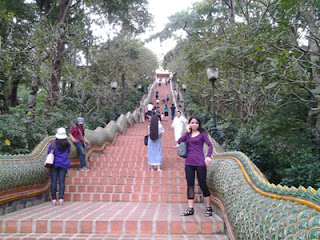Wat Doi Suthep means Temple of Suthep Mountain. Doi Suthep (Suthep Mountain) is a designated national park which starts about 2km north of Chiang Mai by the zoo and the university.
Wat Doi Suthep is located near the top of the mountain. It is a 30 to 35 minute drive. To get there you can either hire a private taxi (it costs between 400 to 500 Thai Baht for a return journey) or jump on a shared red songthaew. It is normal to hire a taxi or catch a songthaew for the return journey.
If you are travelling alone, and you want to try and save money, walk or take a red songthaew to Pratu Chang Phuak, this means White Elephant Gate. Chiang Mai old city has four gates (North, South, East and West). Pratu Chang Phuak is the east gate. From Pratu Chang Phuak if you wait for a while you can join a shared taxi. As a foreigner expect to pay around 100 - 150 baht per person in a shared taxi. On a Sunday there are lots of Thai people going there to worship and this is the easiest day to get a shared taxi.
Wat Doi Suthep is one of the most important temples in the Chiang Mai region, and arguably the most interesting.
The view from the temple is the biggest draw. There are some great view points on the way up to the temple. On the south side of the temple visitors can see the entire plain where Chiang Mai city is located. On a clear day the view is stunning.
When you arrive at the temple you have two options: climb a magnificent 400 step staircase, or take the funicular railway. Able bodied visitors can, and should, climb the staircase. The funicular railway is the best option for the elderly and those with restricted mobility.
On each side of the staircase there are tiled Naga statues forming the baluster rail. At the bottom of the staircase, there is a popular place to take group photographs between the heads of these two Nagas.
Foreigners are required to purchase an entrance ticket at the booth at the top of the stairs.
You enter into a courtyard where shoes must be removed before entering the inner part of the temple.
The inner temple is a walled courtyard with a golden shrine at the centre.
The shrine is similar to the Golden Temple in Bangkok, although smaller. The main part of the shrine consists of a golden stupa. If you wish, join the Thais in walking around the shrine clockwise 7 times. Purchase a lotus flower and incense (20 Baht each) to hold between hands held in prayer to get the full experience, and observe the correct custom.
Around the walls of the inner temple you will find a mural depicting the story of Hanuman, the monkey god. The story has been adapted from the Hindu holy book called the Ramayana. In the Thai version of the story the monkey god is responsible for the creation of the Thai nation.
There are also a number of rooms with shrines and monks ready to give a blessing. For a small donation a monk will bless you and tie a white piece of string around your wrist.
Once you leave the inner temple take time to visit the outer courtyard to take in the views. You can also participate in Thai Buddhist customs by ringing the 108 bells lining the outer courtyard.
Near the entrance, on your way out, you will see a large gong (it is pictured). The challenge is to make a sound from the gong by rubbing the nipple shaped protrusion in the centre in a circular motion. Don't bang the gong, this is cheating and damages the gong. The part of the gong where you rub is very shiny and testament to millions of failed attempted to make it 'sing'.



No comments:
Post a Comment